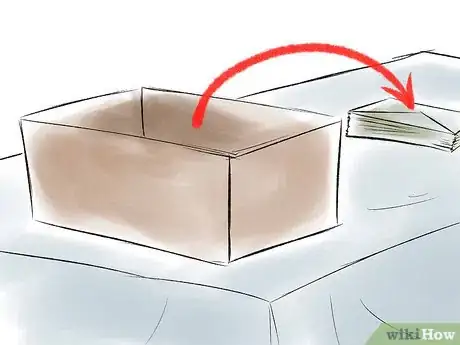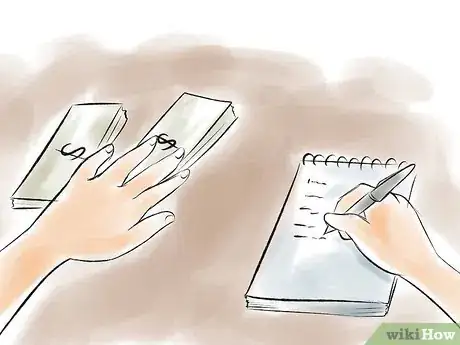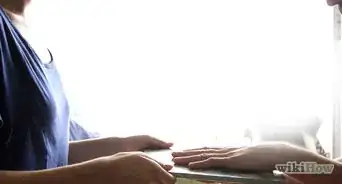X
wikiHow is a “wiki,” similar to Wikipedia, which means that many of our articles are co-written by multiple authors. To create this article, 14 people, some anonymous, worked to edit and improve it over time.
This article has been viewed 45,906 times.
Learn more...
Counting the offering in church should be an organized and systematic process. Still, it should be simple.
Steps
-
1Before the service starts, set up the count room with all the supplies needed to count the offering. You will need a count table and enough chairs for all counters, tally forms, Transaction sheets, pens, calculators, stapler, deposit slips, deposit account ink stamp, deposit bag(s).
-
2Once the offering is taken, have at least 2 or 3 people proceed to the safe to lock up the offering. No one person should be in the room once the offering has been taken. This is known as dual control.Advertisement
-
3Once the Offering is secure, return to the service. The offering will not be counted until after the close of service.
-
4After the service, all counters should proceed to the count room.
-
5Enter the count room. (Men, do not wear your jackets into the count area.) Once entering, put all purses, books and papers, etc. in a designated area away from the count table. Your table should already be set up with everything needed to do the count.
-
6Remove the offering from the safe and place it on the table.
-
7Pray.
-
8Empty the container onto the table and put the empty container aside off the table.
-
9Separate the loose plate cash from the checks and enveloped offering.
-
10Open each envelope. Check the following for each:
- Make sure the envelope is filled out with at least a name. If it is not, you can fill out the envelope if it contains a check. If it contains cash there is no way for you to know who the contributor is so put the cash in with the loose plate cash.
- Check the amount in the envelope against the amount written on the envelope. Make a correction on the envelope if necessary.
- Write on the envelope either "Cash" or "Check". If the envelope contains both, make sure you write both "Cash and "Check", specifying an amount for each.
- As you empty the envelopes, separate the checks from the cash, and further separate the cash by denominations. Put each denomination in the proper denomination basket and the checks in a pile.
- After all envelopes are emptied, run a tape on the cash envelopes and a separate tape on the check envelopes.
-
11Depending on how many counters you have, assign at least two or more counters to the cash and one or more counters to the checks.
- Cash counters will each take a tally sheet. Each will fill out their tally sheet as they count the cash. In the end all tally sheets should be the same. If they are not find and fix the error.
- Cash counters will counter the loose cash, following the same process as outlined in step 13.
- Check counters will sort the checks from lowest amount to highest amount (by sorting them in this manner, it will be easier to find an error later should the totals not match). One person will run a tape on the checks. Then another person will run a tape. The two tapes should be the same. If they are not find and fix the error.
-
12Compare the tapes of the cash and check envelopes with the tapes of the actual cash and checks. They each should match.
-
13Place the funds received in a lockable canvas cash bag. Use a bag with only two keys–one you keep at the bank, the other at the church in a secured location
-
14Bonded trustee will make the deposit the same day into the bank
Advertisement
Community Q&A
-
QuestionIf three donations are made by the same person, can I add them together?
 Community AnswerIt's best to treat each donation as separate, as the donator may donate for separate reasons.
Community AnswerIt's best to treat each donation as separate, as the donator may donate for separate reasons. -
QuestionWhat do I do with the money from the collection that I cannot bank? Is this called a float?
 Victoria ShipmakerCommunity AnswerWe sometimes have coins which cannot be put into the automated bank machine. We keep these as part of the count and note the difference between the count and the deposit. We never pay any bills out of the count or keep any money as part of a float out of the count. Our float is given to us by the treasurer out of the bank account and accounted for. I am making a change to have the money deposited (coins included) into the bank at the teller to avoid having loose change. In Canada we have 1 and 2 dollar coins, so it does add up!
Victoria ShipmakerCommunity AnswerWe sometimes have coins which cannot be put into the automated bank machine. We keep these as part of the count and note the difference between the count and the deposit. We never pay any bills out of the count or keep any money as part of a float out of the count. Our float is given to us by the treasurer out of the bank account and accounted for. I am making a change to have the money deposited (coins included) into the bank at the teller to avoid having loose change. In Canada we have 1 and 2 dollar coins, so it does add up! -
QuestionWhat is the proper way give back change in the offering?
 Community AnswerCongregation should be asked to fill out an envelope if they are expecting change. The envelope should have an area that should state amount enclosed and amount of change expected back. The envelopes should be opened by at least two financial officers who will verify the money and initial in the expected change area so it will be known who issued the change. Change should be returned to the congregant immediately after service or during service if permitted.
Community AnswerCongregation should be asked to fill out an envelope if they are expecting change. The envelope should have an area that should state amount enclosed and amount of change expected back. The envelopes should be opened by at least two financial officers who will verify the money and initial in the expected change area so it will be known who issued the change. Change should be returned to the congregant immediately after service or during service if permitted.
Advertisement
About This Article
Advertisement






































































